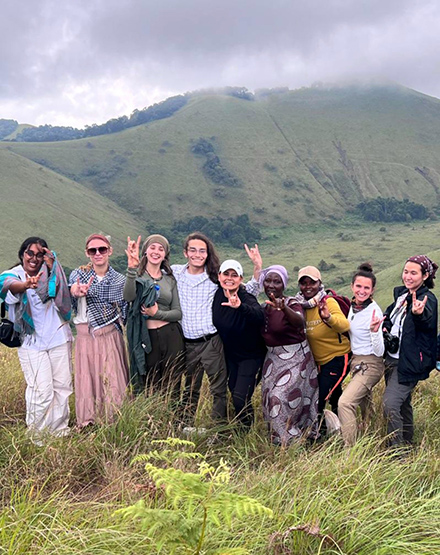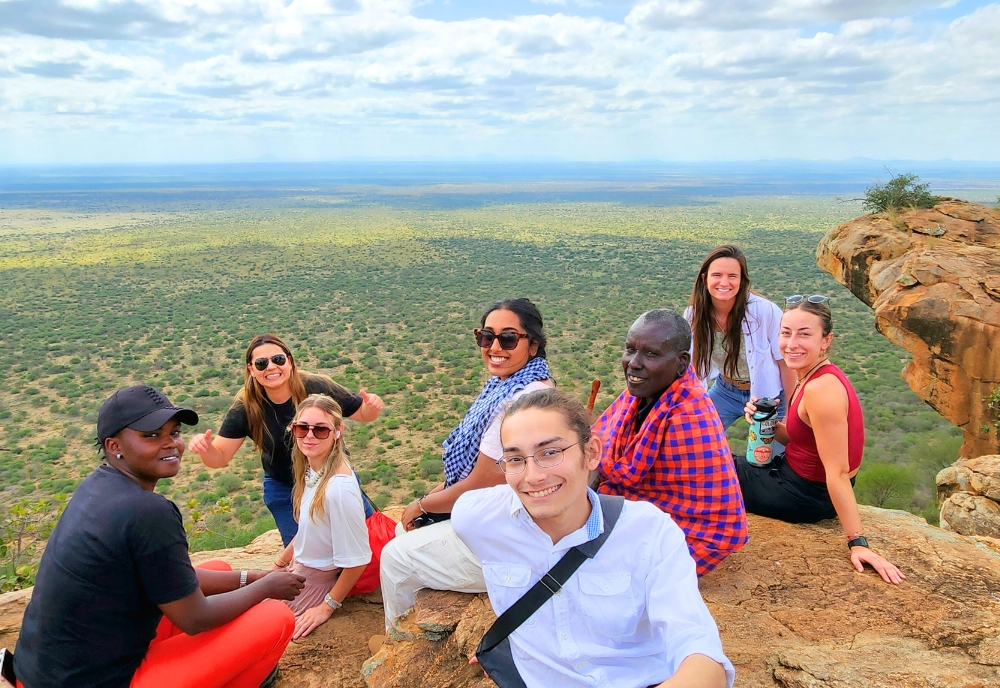Dr. Dillon Mahoney, associate professor of applied anthropology at the College of Arts and Sciences, and nine USF students traveled to Kenya this summer for a month-long visit to experience the USF Kenya Conservation and Sustainability Field School, providing an up-close look at Kenya’s conservation and sustainable development practices.

Students at the top of the Chyulu Hills, Kenya, the site of many important “cloud forests,” or high-altitude rainforests. (Photo courtesy of Dr. Dillon Mahoney)
Mahoney began planning the field school with two Kenyan co-directors–Stan Kivai and Nancy Moinde from the Kenya Institute of Primate Research–more than 10 years ago to fill a need for a more unique field school experiences that brought together their specific areas of interest. The trio, who all have previous experience directing other field schools in Kenya, worked together to organize this year’s pioneer group of USF students and currently manage all logistics and budgeting aspects of its operation.
“Our goal was to put students into intensive learning situations overseas where they could learn directly from Kenyan academics, researchers, and community leaders and members. Our focus is on conservation and sustainable development, and students are confronted with an array of issues from water scarcity to the formation of conservancies to human-wildlife conflict with which to engage,” Mahoney said.
“The goal is not to come up with solutions for Kenya's problems. Rather, I think the students were struck fairly early by how much we can learn from what Kenyans are doing on the ground. Their community-based initiatives and awareness of climate change is far beyond what we have in the United States, and so a major goal is to get students to learn ideas they can take back and test or implement elsewhere,” he added.
Mahoney explained that both Kivai and Moinde hold PhD degrees in anthropology and
are trained primatologists. The three were on the ground each day of the field school
with the students.
In addition to the opportunity to learn abroad, students also develop and conduct
their own small research projects, setting them up for future research endeavors.
“Not only is it a CV and personal-statement builder, but I really think several students
will be using what they learned to apply for graduate school or Fulbright fellowships
moving forward,” Mahoney said. “Further, the experience shows that the students are
willing and able to communicate across cultural and linguistic boundaries. This is
essential to demonstrate for future success.”
The field school, which is open to both undergraduate and graduate students of any
major, aims to have 10 USF students and five Kenyan students enroll in the course
experience each year.
This year’s cohort encompassed students from interdisciplinary backgrounds including from education, environmental engineering, anthropology, and sustainability.
Graduate students are offered directed research credits and undergraduate students are enrolled in Environmental Anthropology and Methods in Cultural Research.
“The field school is framed broadly around an interdisciplinary, environmental anthropology approach, which mandates the blending of nature with humans,” Mahoney said. “Students also conduct independent, largely interview-based research projects. This training and oversight come from the Methods in Cultural Resource course. In addition to field trips and topical lectures while in Kenya, there are also classes specific to the environmental anthropology of our location and the methods we can use.”
An added benefit of the field school, Mahoney explained, is that it puts USF students into active research roles with Kenyan research scientists, not just to get research experience, but to also experience the complexities of conducting research in areas like rural Kenya.
"The key for learning issues around policies of environmental governance is to witness it from a field context. Being there allows students valuable insights into the diversity of local scenarios. One highlight was our 'Think Tank' project, where students actively debate and generate policy recommendations from what they have seen and learned,” Moinde said.
The field school experience included visits to one of East Africa's largest cities, Nairobi, located in Kenya’s Eastern Province and is known as a center for international development and conservation efforts around the continent.
Students spent most of their time between the towns of Kimana and Kibwezi, exploring the broader Amboseli-Tsavo ecosystem in southeastern Kenya. A biodiversity hotspot, the counties of Kajiado and Makueni, where the students spend most of the field school, have recently attracted major international attention as a target for interventions by international conservation organizations.
Much of the field school consists of daily field trips and excursions into national parks and conservancies. While visiting each site, students gained experience with a variety of methods such as biodiversity surveys, ethnographic interviews, and techniques for conflict resolution between humans and wildlife and between local communities and conservation organizations.
“Because this was our first year, our major achievement was simply running the field school successfully and showing that it could be done. Our major finding, we might say, is that there are many different conservancy models emerging across rural Kenya, but they are not all coordinating well with one another. Rather, many are competing, and they are struggling with inconsistent regulations and taxation from the central government and inconsistent funding from international donors. If the conservancy models fail, that could bring real trouble for the future,” Mahoney said.
The students were also able to conduct independent research projects on topics of
their choosing while at the field school.
“These projects may have been the greatest success, and we hope to compile all of
this research as we move forward annually. This year, student projects focused on
topics like generational leadership issues, language and cultural loss, the role of
the educational system in understanding climate change, the culture of reuse, local
understandings of 'corruption,' and the long-term viability of sand dams and other
water management systems. All these projects could develop into long-term graduate
work for these students,” Mahoney said.
Environmental engineering student Regina Demechko said the field school experience provided her the opportunity to study conservation somewhere unique.
Her research project focused on observing water conservation and distribution methods in Kenya, specifically sand dams, and exploring whether they are sustainable solutions to capturing water in Kenya.
“The experience helped me connect with culture in a way that I never have,” she said.
“Being fully immersed in it gave me a new perspective to educating myself. The highlight
was visiting villages around rural Kenya and truly connecting with the people there.
Also, the wildlife was incredible! This study abroad isn't about luxury, it's about
fully experiencing culture in a way that enhances your learning,” she added.
Mahoney adds that they plan on holding the field school experiences every May and
June for three to four weeks.
To learn more about joining the field school, please contact Dr. Dillon Mahoney or visit Education Abroad for more information.
